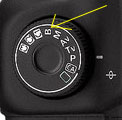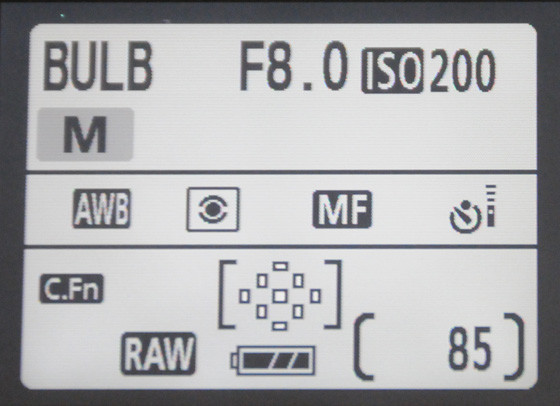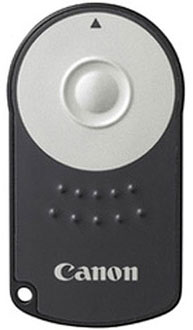- ITA -
La modalità "bulb" o comunemente indicata con la lettera "B" sulla ghiera della vostra fotocamera, è una tipologia di scatto che vi permette di eseguire pose molto lunghe.
Solitamente le reflex digitali, con qualche eccezione, arrivano a tempi di posa di 30 secondi, dopo i quali è impossibile permettere all'otturatore di rimanere aperto.
Ruotando, quindi, la ghiera su B avremo la possibilità di scattare immagini davvero molto suggestive anche oltre il minuto e più.

In alternativa, è possibile selezionare questa opzione direttamente dal menù della fotocamera, ottenendone conferma sul vostro schermo LCD.

Il campo in cui questa opzione viene più utilizzata è sicuramente quello astronomico.
La maggior parte delle volte per poter realizzare scatti ad oggetti che si trovano nel cielo profondo quali nebulose, cluster di stelle e così via, si devono eseguire pose ripetute da almeno cinque minuti.
Questo perchè la luminosità di tali oggetti è assai minore di qualsiasi altro componente della volta celeste e richiede più tempo per essere impressionato su di una pellicola o acquisito da un sensore CCD o CMOS.
Qualora si decidesse di utilizzare questo tipo tecnica è necessario avere sempre un cavalletto, il quale ci assicurerà stabilità ma in particolare ci farà evitare il fastidiosissimo micro mosso che si andrebbe inevitabilmente a creare.
Un'altro accessorio importante è lo scatto remoto. E' chiaro che meno sollecitazioni si posssono avere e più nitida sarà la nostra fotografia. Sarà, dunque, necessario munirsi di un telecomando a filo, IR o wireless per poter comunicare alla fotocamera il tempo di scatto desiderato e senza aver bisogno di doverla toccare.

Un'altro suggerimento importante, potrebbe essere quello di utilizzare il blocco dello specchio. Anche se normalmente questa funzione non viene molto considerata, anche grazie a stabilizzatori ottici molto utili per ottenere foto nitide e precise, durante una posa a lunga esposizione si potrebbe rivelare fondamentale.
E' chiaro che avendo la possibilità di comandare alla mia reflex la quantità di tempo necessaria affinchè il mio otturatore rimanga aperto, potrò anche chiedere allo specchio di alzarsi o abbassarsi quando desidero per annullare così il più possibile ogni tipo di movimento.
Le variabili, chiaramente, sono tante ma con un pò di pratica questa tecnica può rivelarsi davvero appassionante e piena di piacevoli sorprese.
Non resta che provare, provare e provare!
Buon divertimento!
Sensibilità ISO <--> Program Mode
- ENG -
Mode "bulb" or commonly referred to with the letter "B" on the bezel of your camera, is a type of shooting that allows you to make long exposures.
Usually DSLRs, with few exceptions, they arrive at shutter speeds of 30 seconds, after which it is impossible to allow the shutter to stay open.
Turning, then, the dial to B will have the opportunity to take pictures really very impressive even beyond the minutes and more.
Alternatively, you can select this option directly from the menu of the camera, obtaining confirmation on your LCD screen.
The field in which this option is the most used is certainly the astronomical.
Most of the time in order to realize shots to objects that are located in the deep sky as nebulae, star clusters, and so on, he must perform poses repeated for at least five minutes.
This is because the brightness of these objects is much smaller than any other component of the sky and takes longer to be impressed on a film or acquired by a CCD or CMOS sensor.
Should you decide to use this technique you must always have a tripod, which will ensure stability but in particular we will avoid the annoying micro moved that would inevitably create.
Another important accessory is the remote shooting. It 'clear that the less stress you have posssono and the sharper our photography. It will, therefore, necessary to have a wired remote control, IR or wireless to communicate to the camera the desired shutter speed and without the need of having to touch.
Another important tip might be to use mirror lockup. Although normally this function is not very considered, thanks to optical stabilizers very useful for sharp pictures and precise, pose during a long exposure could prove vital.
It 'clear that having the ability to control my reflex the amount of time necessary so that my shutter remains open, I will also ask the mirror to stand or sit up when I want to cancel as much as possible any kind of movement.
The variables, of course, are many but with a little practice this technique can be very exciting and full of pleasant surprises.
You just have to try, try and try!
Have fun!
©Marco Pollini 2018 - All rights reserved










